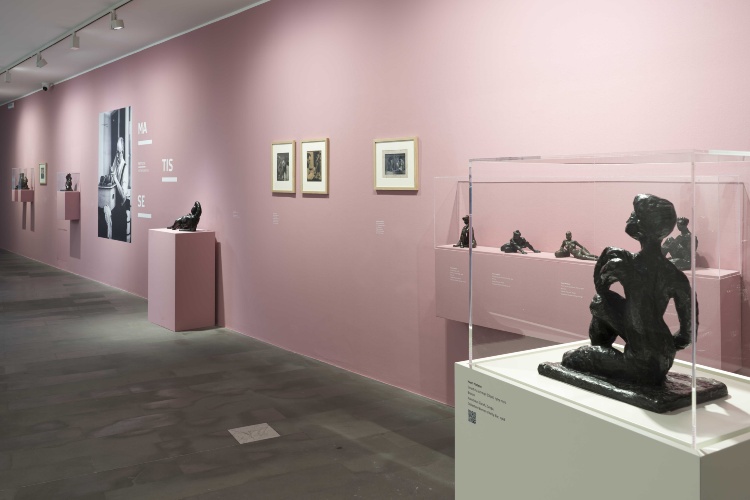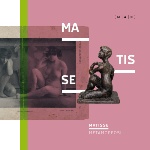
Main site sections
Matisse | Metamorfosi
14.07
-
12.11.2023
curated by Chiara Gatti
based on the concept by Sandra Gianfreda, Kunsthaus Zürich with Claudine Grammont, Director of the Graphic Art Department, Centre Pompidou
Henri Matisse was one of the greatest artists of the twentieth century, although paradoxically an important part of his work is still overlooked. Indeed, Matisse the sculptor is little known in the subtlest folds of his research. Although painting always remained his main mode of expression, “his” language and way of investigating the visible to which he dedicated his entire life, Matisse simultaneously conducted a reflection on sculpture (and also engraving) that makes him one of the most complete artists of the last century. Highly versatile, he explored various techniques at the same time, with curiosity and penetrating experimentation. Against the backdrop of this multifaceted intelligence, Matisse’s sculptural work reveals a parallel life to that of the colourist, a double soul devoted to matter, volume and space, which deserves to be placed in relation – in terms of processes and goals – to that of other great twentieth-century sculptors, who learned from Auguste Rodin and became geniuses of the avant-garde. From Brancusi to Giacometti, Boccioni and Wotruba.
For the first time in Italy, the Museo MAN is dedicating an exhibition to sculptures by Henri Matisse. The exhibition project, curated by Chiara Gatti, reinterprets the unprecedented and complex concept of the Matisse Métamorphoses exhibition staged in 2019 by the Kunsthaus in Zurich and the Musée Matisse in Nice, adapting it to the spaces of the Sardinian museum. This is a project that will lead us to rethink Matisse, to reconsider the role of his work within the art scene of the first half of the twentieth century, in the light of more extensive aesthetic research that sees sculpture as the vehicle for new and revolutionary formal solutions. Within this necessary exploration, the human figure particularly emerges as the main theme of his interest in synthesis. From his investigation of the body, posture, gesture and physiognomy, Matisse developed a process of geometrically reducing the image, leading him towards an abstraction bordering the radical. As the artist himself affirmed in 1908 in his Notes d’un peintre: “what I am most interested in is not the still life or the landscape, but the figure.” The figure, not for its pathos, lyricism, moods or existential inflections, but for its sense of presence in space and its ideal evolution in time. Indeed, Matisse questioned the body’s relationship with the immediate environment and with changing circumstances over an extended period of time. Here then is the evolution of a naturalistic factor into a final synthesis that sublimates contingency into a dimension of absolute perfection. In its turn, space conditions a system of subtle relationships between physical substance and inhabited void, between gestures and the dynamic lines they draw in the air.
The exhibition therefore starts with an analysis of the artist’s method of creation and his transformation of the figure in serial variations. It aligns sequences of bronzes, dating from the early 1910s to the 1930s, and subjects presented in their various successive states and juxtaposed with the artist’s sources of inspiration, including photographs of nudes and posed models, as well as an essential selection of a few paintings in which the motifs themselves reveal the dual soul of his parallel research in painting and sculpture, particularly when dealing with the dominant themes of the nude, dance and the odalisque. Through some thirty sculptures and around twenty drawings and engravings, as well as period photographs and original films, Matisse’s sculpture will be showcased in relation to the subjects of a lifetime, his magnificent obsessions with the female form, his physiognomic studies of models, poses and the plasticity of volumes.
Against the backdrop of this composite research, there are many unique figures, such as Le tiaré, of which no different stages exist, while others are repeated at different intervals, varying and transforming, as in the case of the famous Jeannette (I-V) cycle. From here, the artist developed a conceptual approach that can be described as a kind of method of formal progression. As in a “metamorphosis”, which explains the exhibition title, his figures evolve from a natural transcription to a radical synthesis of the visual factor.
In his painting too – as has been widely studied by critics in the past – it is possible to observe this process of metamorphosis, albeit without ever going so far as to consider real cycles of works as “series”, but rather as the result of a long process of elaboration that finds sculpture and graphics, alongside painting itself, to be instruments of investigation connected with one another, in keeping with the idea of a fluid boundary between techniques. One example is the Odalisque in the Museo Novecento in Milan, which finds subtle and surgical links and relationships with contemporary drawings and bronzes, set out in sequence in the exhibition.
Click here to listen to the audio guide
Technical details
In collaboration with Kunsthaus Zürich, Musée Matisse de Nice
Exhibition organized in collaboration with Manifesto Expo
Bilingual IT/EN catalogue: Sole24ore Cultura
Texts by Sandra Gianfreda, Bärbel Küster, Chiara Gatti
Media Partnership : Radio Monte Carlo - www.radiomontecarlo.net
Press Office
STUDIO ESSECI - Sergio Campagnolo Via San Mattia 16, 35121 Padova
Tel. +39.049.663499
contact person Simone Raddi, simone@studioesseci.net www.studioesseci.net






